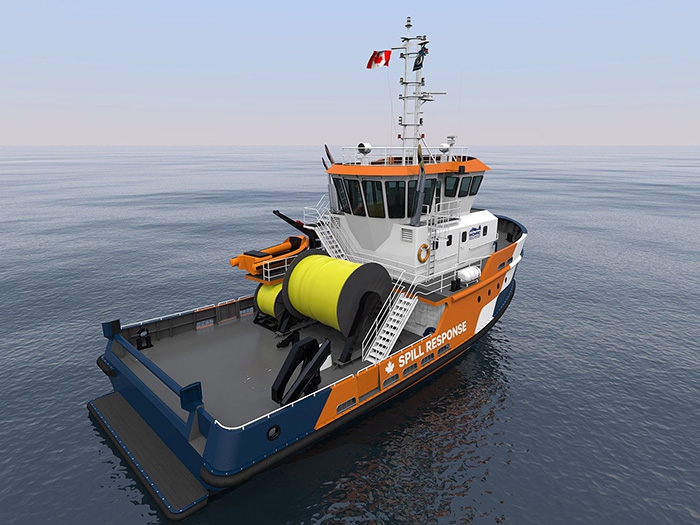
ASL Shipyard to build Coastal Response Vessel trio
Written by Nick Blenkey
OCTOBER 4, 2017 — Burnaby, BC, based Western Canada Marine Response Corporation (WCMRC) recently awarded ASL Shipyards, Singapore, a construction contract for three of Robert Allan Ltd. designed BRAvo 2500 pollution response vessels.
The vessels will increase WCMRC’s offshore spill response capability for the Trans Mountain pipeline expansion project. Robert Allan Ltd. was awarded the design contract for the vessels in late 2016 for the BRAvo 2500 vessels.
The best possible solution to meet WCMRC’s response requirements was assessed through a collaborative process and incorporated into the design.
Identified as Coastal Response Vessels by WCMRC, the modern pollution response platforms were custom designed to meet the formidable environmental conditions and demanding requirements of Canada’s exposed west coast.
They will act as a mothership to other smaller vessels during training exercises and in the response to a spill, should it occur. They will be capable of deploying leading containment technologies, transferring equipment between vessels, and will give WCMRC the flexibility to utilize the vessel’s internal tankage or to offload oil into barges.
Particulars of the BRAvo 2500 pollution response vessels are as follows:
Length: 25.0 m
Beam: 10.25 m
Depth: 3.80 m
Draft, Maximum: 2.8 m
Capacities (at 98%):
Fuel oil: 53 cu.m
Fresh water: 12 cu.m
Recovered oil: 26 cu.m
The hull form, which features a bulbous bow, was extensively studied with computational fluid dynamics and will allow the resiliently mounted EPA Tier 3 compliant Caterpillar C9.3 main engines to propel the vessel at a speed of at least 10 knots. Two Caterpillar C4.4 ship service gensets, in soundproof enclosures, will provide electrical power for vessel services, including the deck machinery.
A spacious deck aft is equipped with 2,500 ft. of Kepner self-inflating offshore containment boom stored on a large powered reel and a NOFI Current Buster 4 sweep system, which can be deployed and towed by the Coastal Response Vessel to capture oil in current and waves.
These booms are deployable over an aft roller to minimize wear during training exercises and an aft swim platform allows easy access to the water surface for recovering and deploying equipment with the vessel’s crane.
The vessels will also ease the transfer of spill responders from small workboats with limited freeboard.
On the main deck, large lockers for handling loose spill response equipment are provided along with a large wet gear entry space to deal with the west coast’s extremely wet climate. The entry space can be used as an internal decontamination area during a spill. Crew accommodations are also arranged on this level, featuring a generously sized mess, galley and crew rooms. With the deckhouse above, which includes two large cabins and an office, the vessel is designed to accommodate 8 people in quiet MLC compliant cabins, satisfying all Transport Canada regulations.
The wheelhouse provides exceptional all around visibility, especially to the aft deck to allow the master to actively maneuver the vessel using its twin screw propulsion and the bow thruster while still supervising the deployment and recovery of spill response equipment.
Due to the harsh environmental conditions, significant effort was spent during the design to reduce the vessel’s motions in waves to the maximum extent possible. This included implementing Robert Allan Ltd.’s unique hull sponson technology from the successful RAstar series of offshore escort tugs, as well as large bilge keels, twin skegs and a bulbous bow. The vessel’s stability was also assessed to optimize rolling period and not only satisfy regulatory requirements, but also implement Robert Allan Ltd.’s recommendation for one compartment damage survivability.
WCMRC selected Lloyd’s Register as the classification society for the vessels with Robert Allan Ltd. contracted to coordinate plan approval to LR’s rules as well as Transport Canada requirements.
The vessels are designed to the following notation: LR ✠100A1 SSC, Workboat, Mono, G4, UMS, IWS – Oil Recovery Workboat with Occasional Towing Duties.






Leave a Reply
You must be logged in to post a comment.